Development and Investigation of PEDOT:PSS Composition Coated Fabrics Intended for Microwave Shielding and Absorption
Abstract
1. Introduction
2. Materials and Methods
2.1. Materials and Their Treatment
2.2. Methods
2.2.1. Structural Parameters
2.2.2. SEM Analysis
2.2.3. Electrical Conductivity
2.2.4. EMR Shielding, Reflection and Absorption
2.2.5. Calculation of the Surface Conductivity according to the Measurements of Reflectance and Transmittance
2.2.6. Evaluation of Conductive Coating Durability on Washing
2.2.7. Evaluation of Conductive Coating Durability on Abrasion
3. Results and Discussion
3.1. Electrical Conductivity
3.2. Microwave Properties
3.3. Washing and Wearing Resistance Performance
4. Conclusions
Author Contributions
Funding
Institutional Review Board Statement
Informed Consent Statement
Data Availability Statement
Conflicts of Interest
References
- International Agency for Research on Cancer (IARC). Radiation, Part 2: Non-Ionizing Radiofrequency Electromagnetic Fields, Monographs on the Evaluation of Carcinogenic Risks to Human; IARC: Lyon, France, 2013; Volume 102. [Google Scholar]
- Teber, A.; Unver, I.; Kavas, H.; Aktas, B.; Bansal, R. Knitted radar absorbing materials (RAM) based on nickel–cobalt magnetic materials. J. Magn. Magn. Mater. 2016, 406, 228–232. [Google Scholar] [CrossRef]
- Geetha, S.; Kumar, K.K.S.; Rao, C.R.K.; Vijayan, M.; Trivedi, D.C. EMI shielding: Methods and materials-A review. J. Appl. Polym. Sci. 2009, 112, 2073–2086. [Google Scholar] [CrossRef]
- Committee for Conformity Assessment on Accreditation and Certification of Functional and Technical Textiles. Specified Re-Quirements of Electromagnetic Shielding Textiles. 2010. Available online: http://www.ftts.org.tw/images/fa003E.pdf (accessed on 16 November 2016).
- King, J.A.; Pisani, W.A.; Klimek-McDonald, D.R.; Perger, W.F.; Odegard, G.M.; Turpeinen, D.G. Shielding effec-tiveness of carbon-filled polypropylene composites. J. Compos. Mater. 2016, 50, 2177–2189. [Google Scholar] [CrossRef]
- Brzeziński, S.; Rybicki, T.; Malinowska, G.; Karbownik, I.; Rybicki, E.; Szugajew, L. Effectiveness of shielding electro-magnetic radiation, and assumptions for designing the multi-layer structures of textile shielding materials. Fibres Text. East. Eur. 2009, 1, 60–65. [Google Scholar]
- Kim, S.H.; Jang, S.H.; Byun, S.W.; Lee, J.Y.; Joo, J.S.; Jeong, S.H.; Park, M.-J. Electrical properties and EMI shielding characteristics of polypyrrole-nylon 6 composite fabrics. J. Appl. Polym. Sci. 2003, 87, 1969–1974. [Google Scholar] [CrossRef]
- Onggar, T.; Kruppke, I.; Cherif, C. Techniques and Processes for the Realization of Electrically Conducting Textile Materials from Intrinsically Conducting Polymers and Their Application Potential. Polymers 2020, 12, 2867. [Google Scholar] [CrossRef]
- Tseghai, G.B.; Mengistie, D.A.; Malengier, B.; Fante, K.A.; Van Langenhove, L. PEDOT:PSS-Based Conductive Textiles and Their Applications. Sensors 2020, 20, 1881. [Google Scholar] [CrossRef] [PubMed]
- Avloni, J.; Ouyang, M.; Florio, L.; Henn, A.R.; Sparavigna, A.C. Shielding Effectiveness Evaluation of Metallized and Polypyrrole-coated Fabrics. J. Thermoplast. Compos. Mater. 2007, 20, 241–254. [Google Scholar] [CrossRef]
- Kaynak, A.; Håkansson, E. Characterization of conducting polymer coated fabrics at microwave frequencies. Int. J. Cloth. Sci. Technol. 2009, 21, 117–126. [Google Scholar] [CrossRef]
- Håkansson, E.; Amiet, A.; Kaynak, A. Dielectric characterization of conducting textiles using free space transmission measurements: Accuracy and methods for improvement. Synth. Met. 2007, 157, 1054–1063. [Google Scholar] [CrossRef]
- Onar, N.; Akşit, A.C.; Ebeoglugil, M.F.; Birlik, I.; Celik, E.; Ozdemir, I. Structural, electrical, and electromagnetic proper-ties of cotton fabrics coated with polyaniline and polypyrrole. J. Appl. Polym. Sci. 2009, 114, 2003–2010. [Google Scholar] [CrossRef]
- Joseph, N.; Varghese, J.; Sebastian, M.T. In situ polymerized polyaniline nanofiber-based functional cotton and nylon fabrics as millimeter-wave absorbers. Polym. J. 2017, 49, 391–399. [Google Scholar] [CrossRef]
- Engin, F.Z.; Usta, İ. Development and characterisation of polyaniline/polyamide (PANI/PA) fabrics for elec-tromagnetic shielding. J. Text. Inst. 2015, 106, 872–879. [Google Scholar] [CrossRef]
- Lee, C.Y.; Lee, D.E.; Jeong, C.K.; Hong, Y.K.; Shim, J.H.; Joo, J.; Kim, M.S.; Lee, J.Y.; Jeong, S.H.; Byun, S.W.; et al. Electromagnetic interference shielding by using conductive polypyrrole and metal compound coated on fabrics. Polym. Adv. Technol. 2002, 13, 577–583. [Google Scholar] [CrossRef]
- Marr, I.; Stöcker, T.; Moos, R. F3—Resistives Gasdosimeter auf Basis von PEDOT:PSS zur Detektion von NO und NO2. Tagungsband 2013, 317–320. [Google Scholar] [CrossRef]
- Ding, Y.; Invernale, M.A.; Sotzing, G.A. Conductivity Trends of PEDOT-PSS Impregnated Fabric and the Effect of Conductivity on Electrochromic Textile. ACS Appl. Mater. Interfaces 2010, 2, 1588–1593. [Google Scholar] [CrossRef] [PubMed]
- Otley, M.T.; Alamer, F.A.; Guo, Y.; Santana, J.; Eren, E.; Li, M.; Lombardi, J.; Sotzing, G.A. Phase Segregation of PEDOT:PSS on Textile to Produce Materials of >10 A mm−2Current Carrying Capacity. Macromol. Mater. Eng. 2017, 302, 1600348. [Google Scholar] [CrossRef]
- Liu, H.; Gong, Y.; Li, X.; Zhang, X.; Hu, C.; Wang, L.; Pang, Y.; Fang, C. The effect of in-situ polymerization on PE-DOT-PSS/PAN composite conductive fiber. In IOP Conference Series: Earth and Environmental Science 2019; IOP Publishing: Bristol, UK, 2019; Volume 218, p. 012161. [Google Scholar]
- Allison, L.; Hoxie, S.; Andrew, T.L. Towards seamlessly-integrated textile electronics: Methods to coat fabrics and fibers with conducting polymers for electronic applications. Chem. Commun. 2017, 53, 7182–7193. [Google Scholar] [CrossRef]
- Ding, Y.; Xu, W.; Wang, W.; Fong, H.; Zhu, Z. Scalable and facile preparation of highly stretchable electrospun PE-DOT: PSS@ PU fibrous nonwovens toward wearable conductive textile applications. ACS Appl. Mater. Interfaces 2017, 9, 30014–30023. [Google Scholar] [CrossRef]
- Rubežienė, V.; Abraitienė, A.; Baltušnikaitė-Guzaitienė, J.; Varnaitė-Žuravliova, S.; Sankauskaitė, A.; Kancleris, Ž.; Šlekas, G. The influence of distribution and deposit of conductive coating on shielding effectiveness of textiles. J. Text. Inst. 2018, 109, 358–367. [Google Scholar] [CrossRef]
- Guo, Y.; Otley, M.T.; Li, M.; Zhang, X.; Sinha, S.K.; Treich, G.M.; Sotzing, G.A. PEDOT: PSS “wires” printed on textile for wearable electronics. ACS Appl. Mater. Interfaces 2016, 8, 26998–27005. [Google Scholar] [CrossRef] [PubMed]
- Åkerfeldt, M.; Strååt, M.; Walkenström, P. Electrically conductive textile coating with a PEDOT-PSS dispersion and a polyurethane binder. Text. Res. J. 2012, 83, 618–627. [Google Scholar] [CrossRef]
- Kaynak, A. Conductive polymer coatings. In Active Coatings for Smart Textiles; Elsevier BV: Amsterdam, The Netherlands, 2016; pp. 113–136. [Google Scholar]
- Bonaldi, R.R.; Siores, E.; Shah, T. Characterization of electromagnetic shielding fabrics obtained from carbon nanotube composite coatings. Synth. Met. 2014, 187, 1–8. [Google Scholar] [CrossRef]
- Pakdel, E.; Wang, J.; Kashi, S.; Sun, L.; Wang, X. Advances in photocatalytic self-cleaning, superhydrophobic and electromagnetic interference shielding textile treatments. Adv. Colloid Interface Sci. 2020, 277, 102116. [Google Scholar] [CrossRef]
- Gashti, M.P.; Ghehi, S.T.; Arekhloo, S.V.; Mirsmaeeli, A.; Kiumarsi, A. Electromagnetic shielding response of UV-induced polypyrrole/silver coated wool. Fibers Polym. 2015, 16, 585–592. [Google Scholar] [CrossRef]
- Hegemann, D.; Brunner, H.; Oehr, C. Plasma treatment of polymers for surface and adhesion improvement. Nucl. Instrum. Methods Phys. Res. B 2003, 208, 281–286. [Google Scholar] [CrossRef]
- Cheng, J.; Zhao, B.; Zheng, S.; Yang, J.; Zhang, D.; Cao, M.-S. Enhanced microwave absorption performance of polyaniline-coated CNT hybrids by plasma-induced graft polymerization. Appl. Phys. A 2015, 119, 379–386. [Google Scholar] [CrossRef]
- Zhou, Y.; Sun, Z.; Jiang, L.; Chen, S.; Ma, J.; Zhou, F. Flexible and conductive meta-aramid fiber paper with high thermal and chemical stability for electromagnetic interference shielding. Appl. Surf. Sci. 2020, 533, 147431. [Google Scholar] [CrossRef]
- Su, M.; Gu, A.; Liang, G.; Yuan, L. The effect of oxygen-plasma treatment on Kevlar fibers and the properties of Kevlar fibers/bismaleimide composites. Appl. Surf. Sci. 2011, 257, 3158–3167. [Google Scholar] [CrossRef]
- Gordon, W.O.; Peterson, G.W.; Durke, E.M. Reduced Chemical Warfare Agent Sorption in Polyurethane-Painted Surfaces via Plasma-Enhanced Chemical Vapor Deposition of Perfluoroalkanes. ACS Appl. Mater. Interfaces 2015, 7, 6402–6405. [Google Scholar] [CrossRef]
- Dou, S.; Tao, L.; Wang, R.; El Hankari, S.; Chen, R.; Wang, S. Plasma-Assisted Synthesis and Surface Modification of Electrode Materials for Renewable Energy. Adv. Mater. 2018, 30, e1705850. [Google Scholar] [CrossRef]
- ISO 23232:2009. Textiles—Aqueous Liquid Repellency—Water/Alcohol Solution Resistance Test. Available online: https://www.iso.org/standard/50923.html (accessed on 15 January 2021).
- EN 12127:1997. Textiles. Fabrics. Determination of Mass Per Unit Area Using Small Samples. Available online: https://standards.cen.eu/dyn/www/f?p=204:110:0::::FSP_PROJECT,FSP_ORG_ID:11546,6229&cs=130ECEF2B5BBBAE89EF1B9A3396F60A81 (accessed on 15 January 2021).
- EN ISO 5084:1996. Textiles—Determination of Thickness of Textiles and Textile Products. Available online: https://standards.cen.eu/dyn/www/f?p=204:110:0::::FSP_PROJECT:11550&cs=197474BEE4A06921FE87D2AEAAECBE564 (accessed on 15 January 2021).
- EN 1049-2:1993. Textiles—Woven Fabrics—Construction—Methods of Analysis—Part 2: Determination of Number of Threads Per Unit Length. Available online: https://standards.cen.eu/dyn/www/f?p=204:110:0::::FSP_PROJECT:11547&cs=1BB22DB1B8E2F47A878DAE6CF64B44AAE (accessed on 15 January 2021).
- EN 1149-1:2006. Protective Clothing—Electrostatic Properties—Part 1: Test Method for Measurement of Surface Resistivity. Available online: https://standards.cen.eu/dyn/www/f?p=204:110:0::::FSP_PROJECT,FSP_ORG_ID:20552,6143&cs=1F5EFE9BBBA3F337AF53D236B7875229B (accessed on 15 January 2021).
- Orfanidis, S.J. Electromagnetic Waves and Antennas 2002; Rutgers University: New Brunswick, NJ, USA, 2002; pp. 227–250. [Google Scholar]
- EN ISO 105-C06:2010. Textiles—Tests for Colour Fastness—Part C06: Colour Fastness to Domestic and Commercial Laun-Dering (ISO 105-C06:2010). Available online: https://standards.cen.eu/dyn/www/f?p=204:110:0::::FSP_PROJECT,FSP_ORG_ID:31693,6229&cs=1925C0DDC367F5DAB74C85D67E6F4E802 (accessed on 15 January 2021).
- EN ISO 12947-2:2016. Textiles—Determination of the Abrasion Resistance of Fabrics by the Martindale Method—Part 2: Determination of Specimen Breakdown (ISO 12947-2:2016). Available online: https://standards.cen.eu/dyn/www/f?p=204:110:0::::FSP_PROJECT,FSP_ORG_ID:37839,6229&cs=19C8C568475C90DBE5D873E986AD4EF02 (accessed on 15 January 2021).
- Kirchmeyer, S.; Reuter, K. Scientific importance, properties and growing applications of poly(3,4-ethylenedioxythiophene). J. Mater. Chem. 2005, 15, 2077–2088. [Google Scholar] [CrossRef]
- Elschner, A.; Loevenich, W.; Eiling, A.; Bayley, J. ITO Alternative: Solution deposited Clevios TM PEDOT: PSS for transparent conductive applications. Heraeus Trade Artic. 2012. Available online: https://www.yumpu.com/en/document/read/10545247/english-cleviostm-conductive-transparent-and-flexible-polymers (accessed on 15 January 2021).
- Lund, A.; van der Velden, N.M.; Persson, N.-K.; Hamedi, M.M.; Müller, C. Electrically conducting fibres for e-textiles: An open playground for conjugated polymers and carbon nanomaterials. Mater. Sci. Eng. R Rep. 2018, 126, 1–29. [Google Scholar] [CrossRef]
- Khan, M.A. Dyeing of Wool and Silk Fibres with a Conductive Polyelectrolyte and Comparing Their Conductance. Master‘s Thesis, 2012. Available online: https://www.diva-portal.org/smash/get/diva2:1308230/FULLTEXT01.pdf (accessed on 15 January 2021).
- Moraes, M.R.; Alves, A.M.V.C.P.; Toptan, F.; Martins, M.S.; Vieira, E.M.F.; Paleo, A.J.; Souto, A.P.; Santos, W.L.F.; Esteves, M.D.F.; Zille, A. Glycerol/PEDOT:PSS coated woven fabric as a flexible heating element on textiles. J. Mater. Chem. C 2017, 5, 3807–3822. [Google Scholar] [CrossRef]
- Ryan, J.D.; Mengistie, D.A.; Gabrielsson, R.; Lund, A.; Müller, C. Machine-Washable PEDOT:PSS Dyed Silk Yarns for Electronic Textiles. ACS Appl. Mater. Interfaces 2017, 9, 9045–9050. [Google Scholar] [CrossRef] [PubMed]
- Deogaonkar, S.C. Dielectric barrier discharge plasma induced surface modification of polyester/cotton blend fabrics to improve polypyrrole coating adhesion and conductivity. J. Text. Inst. 2020, 111, 1530–1537. [Google Scholar] [CrossRef]
- Gupta, K.; Abbas, S.; Abhyankar, A. Carbon black/polyurethane nanocomposite-coated fabric for microwave attenuation in X & Ku-band (8–18 GHz) frequency range. J. Ind. Text. 2016, 46, 510–529. [Google Scholar] [CrossRef]
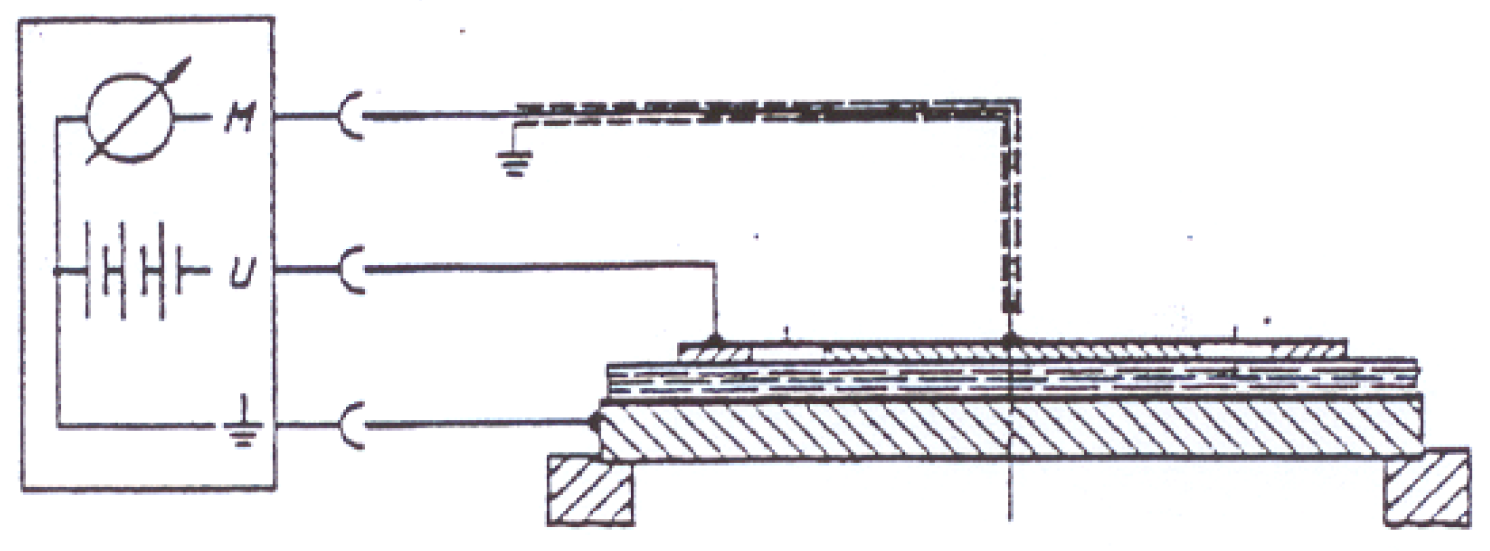


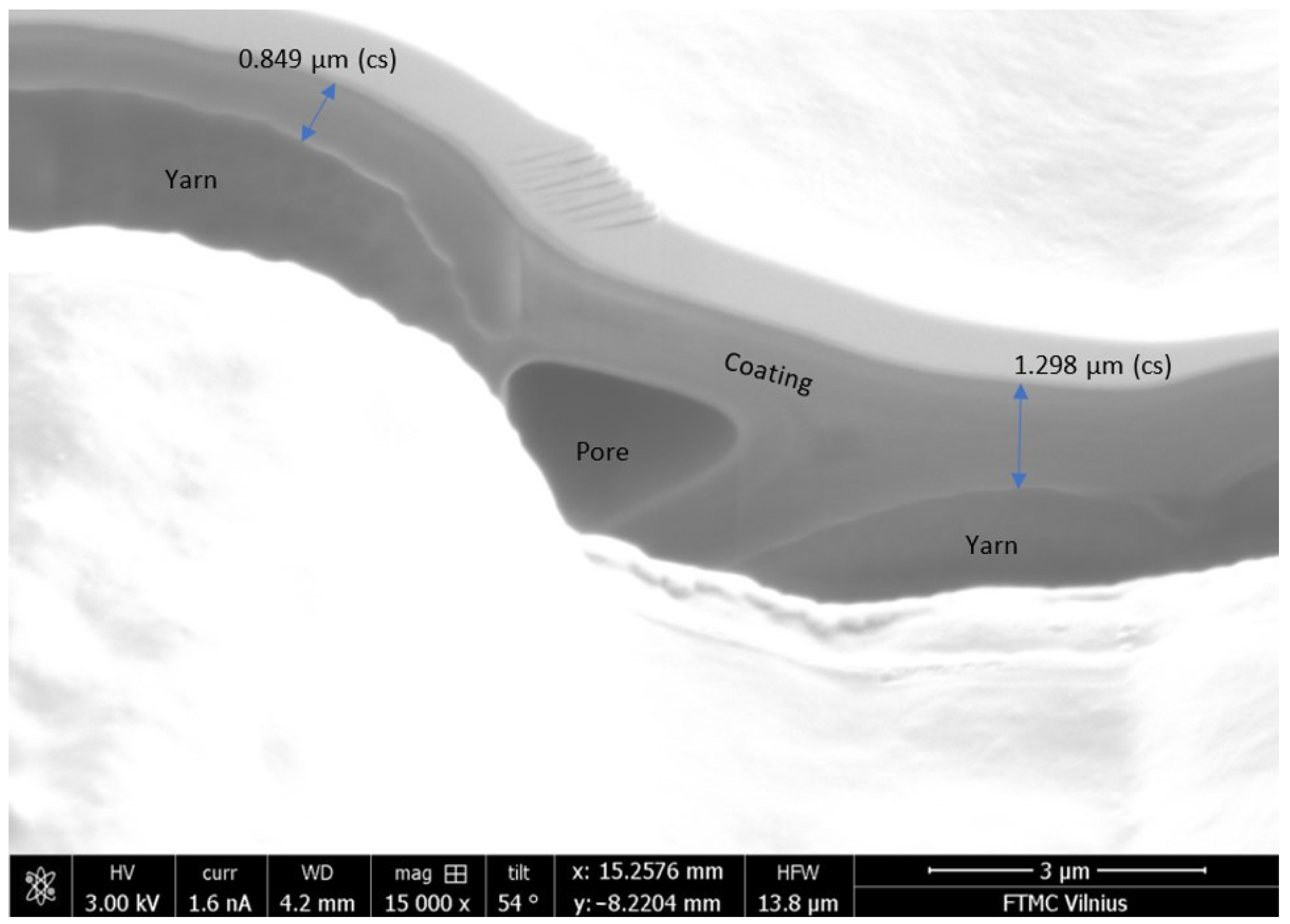




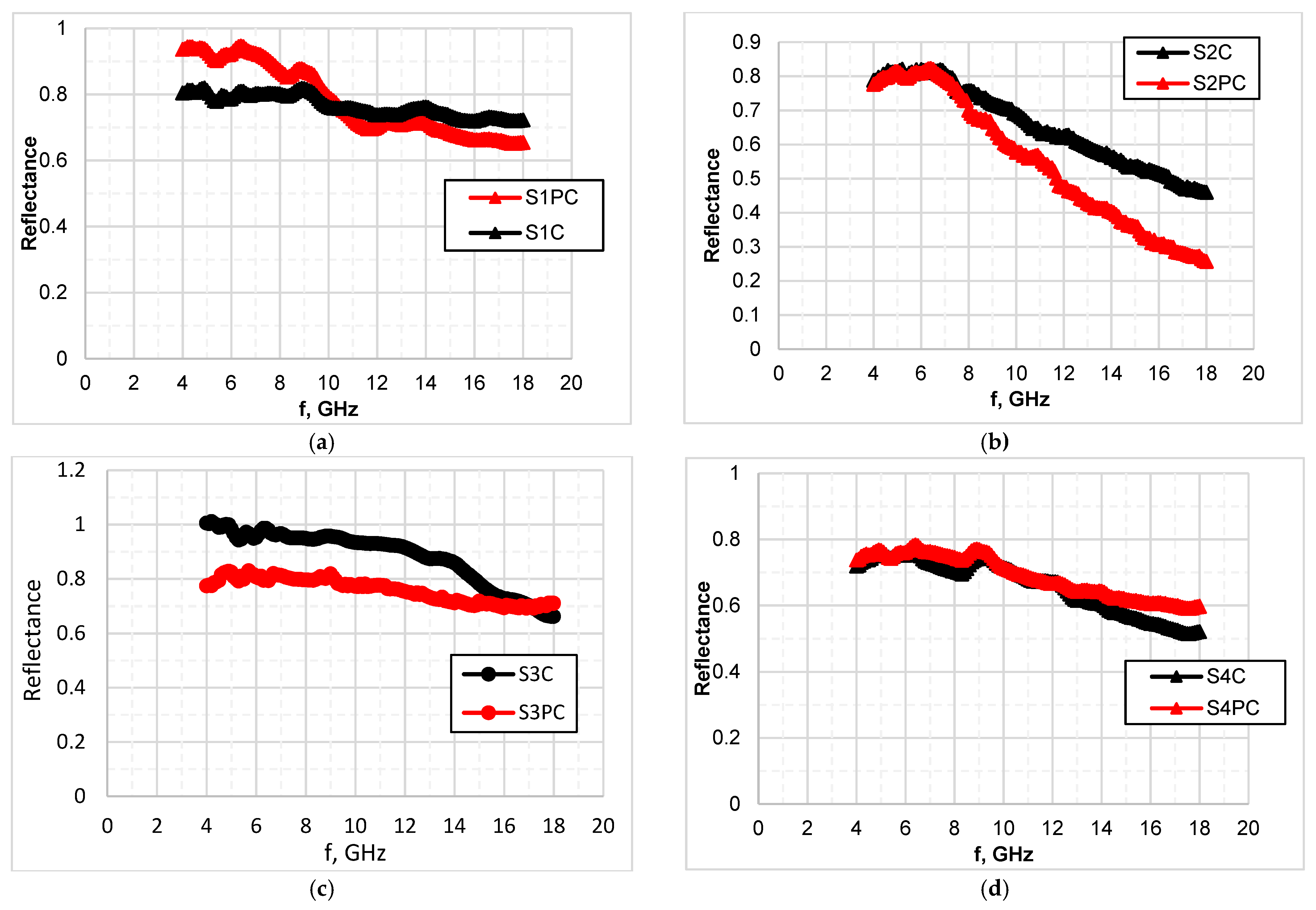
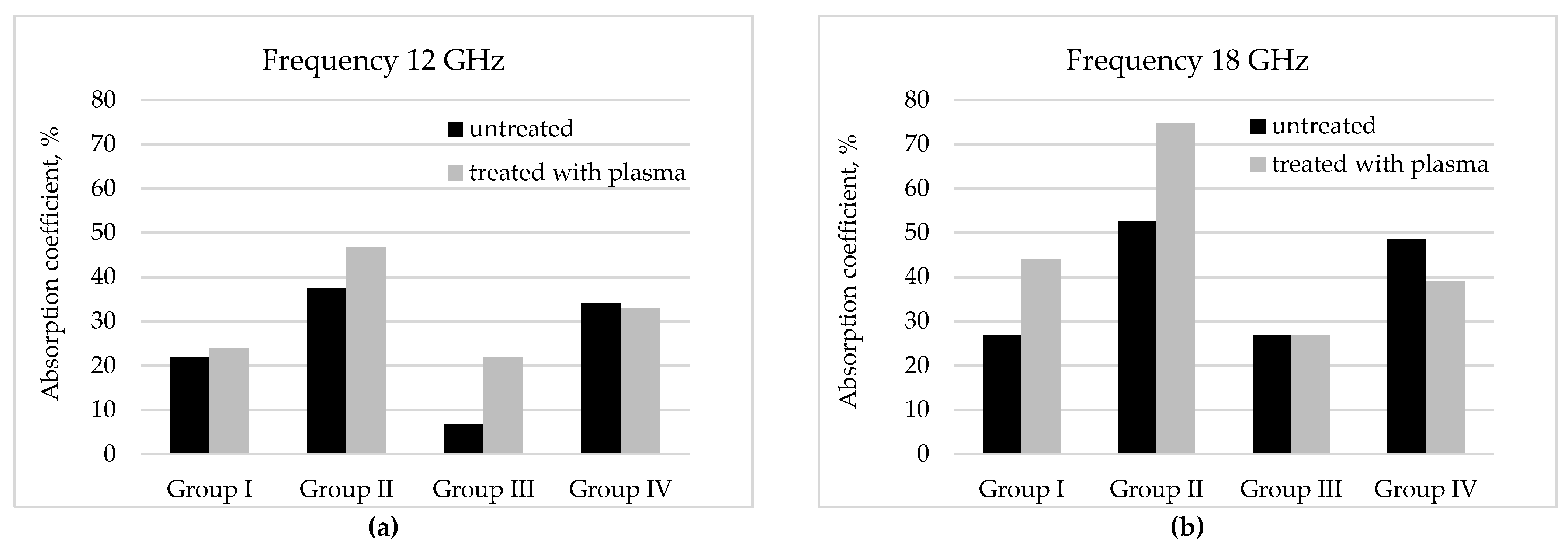
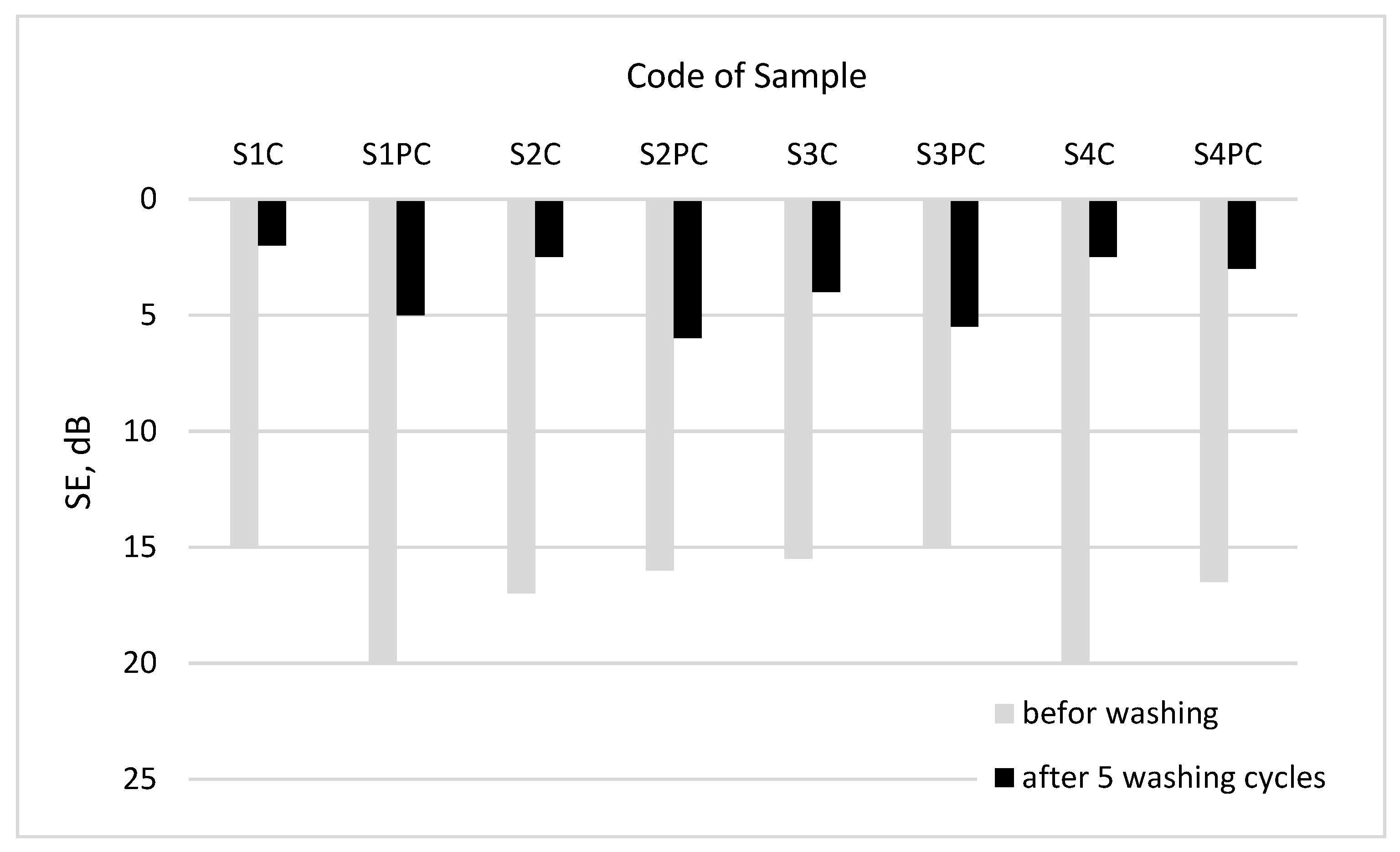

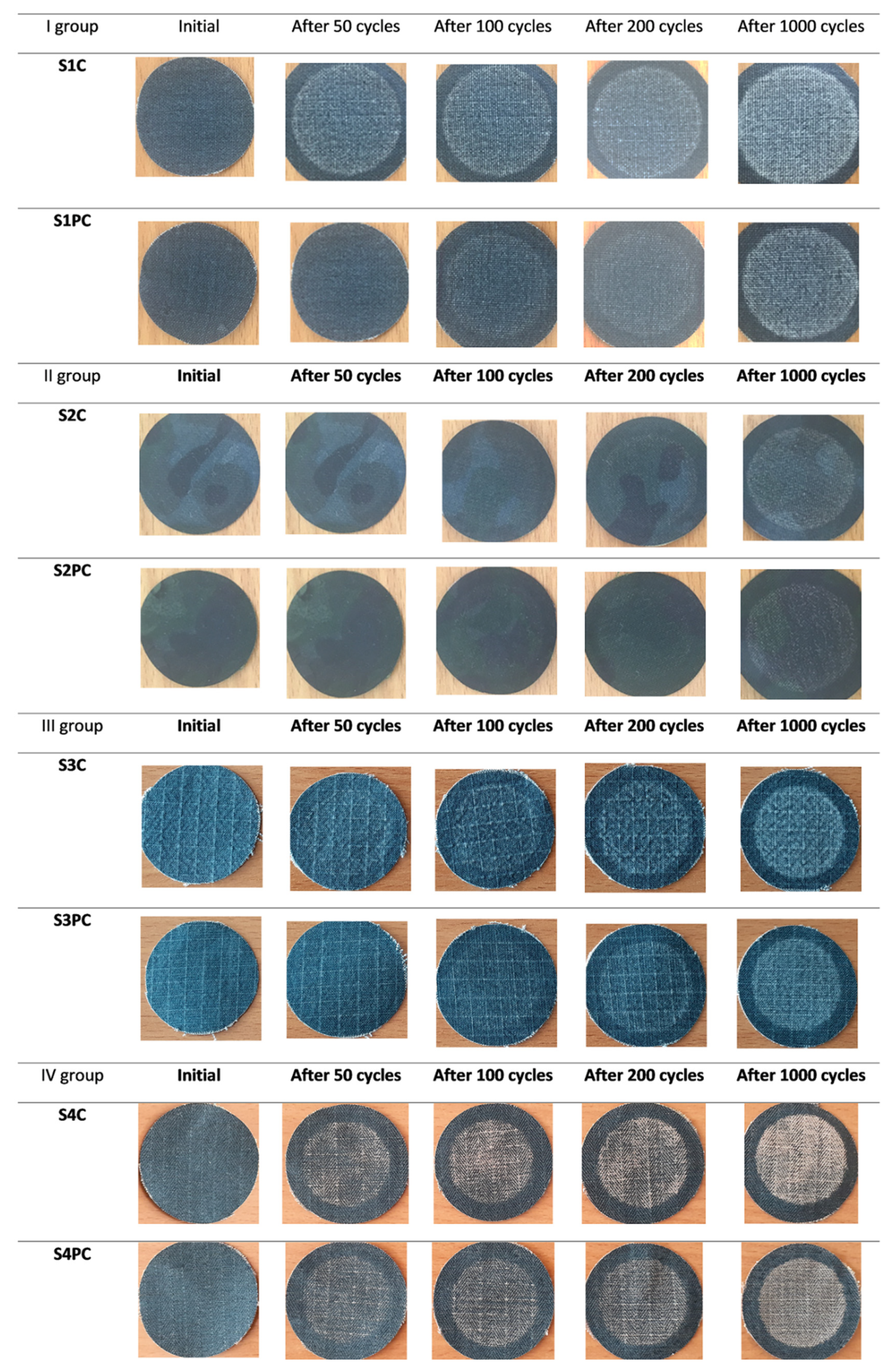
| Group of Samples (and Substrate View, Magnified ×60) | Code of Fabric | Description | Mean Mass Per Unit Area *, g/m2 | Thickness, mm | Number of Threads Per Unit Length | ||
|---|---|---|---|---|---|---|---|
| No. of Warp Threads Per 1 cm | No. of Weft Threads Per 1 cm | ||||||
| I | 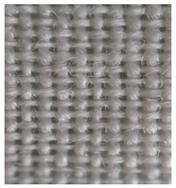 | S1 | Substrate (1)—100 % wool woven fabric (without plasma treatment and without conductive coating) | 127 | 0.49 | 22 | 18 |
| S1C | Substrate (1) coated with conductive paste | ||||||
| S1PC | Substrate (1) treated with plasma and coated with conductive paste | ||||||
| II | 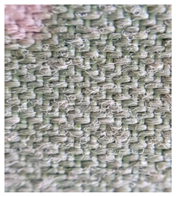 | S2 | Substrate (2)—100 % polyamide woven fabric, printed with camouflage pattern (without plasma treatment and without conductive coating) | 130 | 0.45 | 47 | 32 |
| S2C | Substrate (2) coated with conductive paste | ||||||
| S2PC | Substrate (2) treated with plasma and coated with conductive paste | ||||||
| III |  | S3 | Substrate (3)—58 % cotton/42% polyamide woven fabric (without plasma treatment and without conductive coating) | 227 | 0.67 | 28 | 25 |
| S3C | Substrate (3) coated with conductive paste | ||||||
| S3PC | Substrate (3) treated with plasma and coated with conductive paste | ||||||
| IV | 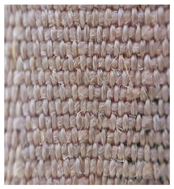 | S4 | Substrate (4)—Aramid/viscose 55%/45% woven fabric, printed with camouflage pattern (without plasma treatment and without conductive coating) | 236 | 0.67 | 38 | 24 |
| S4C | Substrate (4) coated with conductive paste | ||||||
| S4PC | Substrate (4) treated with plasma and coated with conductive paste | ||||||
| Code of Fabric | No Treatment | Treatment (1 Passage) | Treatment (2 Passages) |
|---|---|---|---|
| S1 | Level 3 | Level 1 | Level 1 |
| S2 | Level 0 | Level 0 | Level 0 |
| S3 | Level 3 | Level 1 | Level 0 |
| S4 | Level 0 | Level 0 | Level 0 |
| Properties | |
|---|---|
| Composition/information on ingredients (component name and % by weight) | Propylene glycol ≤ 66.5 2,2′-oxydiethanol ≤ 15 Benzensulphonic Acid, Ethenyl-, Homopolymer, Compd.with 2,3-dihydrothienol[3,4-b]-1,4-dioxin Homopolymer ≤ 15 |
| Surface resistivity (test print) | 700 Ω/sq |
| Product description (supplied form) | Aqueous dispersion |
| Group of Samples | Code of Sample | Surface Resistivity * ρ, Ω | Surface Resistivity *After Washing ρ, Ω |
|---|---|---|---|
| I | S1C | 2.1 × 107 | 1.7 × 108 |
| S1PC | 2.3 × 107 | 2.6 × 108 | |
| II | S2C | 1.7 × 107 | 4.3 × 108 |
| S2PC | 4.4 × 107 | 3.3 × 108 | |
| III | S3C | 8.7 × 107 | 2.1 × 108 |
| S3PC | 3.7 × 107 | 4.5 × 108 | |
| IV | S4C | 1.5 × 107 | 1.0 × 108 |
| S4PC | 5.6 × 107 | 3.7 × 108 |
| Group of Samples | Code of Sample | Dominant Shielding Effectiveness SE, dB (2–18 GHz) | Deposit of Conductive Paste, g/m2 | Surface Conductivity, S |
|---|---|---|---|---|
| I | S1C | 15 | 10 | 2.5 × 10−2 |
| S1PC | 18–19 | 12 | 4.0 × 10−2 | |
| II | S2C | 16–18 | 5 | 3.5 × 10−2 |
| S2PC | 15–17 | 5 | 3.2 × 10−2 | |
| III | S3C | 15–16 | 14 | 2.5 × 10−2 |
| S3PC | 15 | 15 | 2.5 × 10−2 | |
| IV | S4C | 18–20 | 6 | 4.7 × 10−2 |
| S4PC | 17–20 | 7 | 4.7 × 10−2 |
| Group of Samples | Code of Sample | Frequency | |||||
|---|---|---|---|---|---|---|---|
| 12 GHz | 18 GHz | ||||||
| Components of Shielding Effectiveness % | |||||||
| Γ | A | T | Γ | A | T | ||
| I | S1C | 75.0 | 21.8 | 3.2 | 70.0 | 26.8 | 3.2 |
| S1PC | 75.0 | 24.0 | 1.0 | 55.0 | 44.0 | 1.0 | |
| II | S2C | 60.0 | 37.5 | 2.5 | 45.0 | 52.5 | 2.5 |
| S2PC | 50.0 | 46.8 | 3.2 | 25.0 | 74.8 | 2.0 | |
| III | S3C | 90.0 | 6.8 | 3.2 | 70.0 | 26.8 | 3.2 |
| S3PC | 75.0 | 21.8 | 3.2 | 70.0 | 26.8 | 3.2 | |
| IV | S4C | 65.0 | 34.0 | 1.0 | 50.0 | 48.4 | 1.6 |
| S4PC | 65.0 | 33.0 | 2.0 | 60.0 | 39.0 | 0.1 | |
Publisher’s Note: MDPI stays neutral with regard to jurisdictional claims in published maps and institutional affiliations. |
© 2021 by the authors. Licensee MDPI, Basel, Switzerland. This article is an open access article distributed under the terms and conditions of the Creative Commons Attribution (CC BY) license (https://creativecommons.org/licenses/by/4.0/).
Share and Cite
Rubeziene, V.; Baltusnikaite-Guzaitiene, J.; Abraitiene, A.; Sankauskaite, A.; Ragulis, P.; Santos, G.; Pimenta, J. Development and Investigation of PEDOT:PSS Composition Coated Fabrics Intended for Microwave Shielding and Absorption. Polymers 2021, 13, 1191. https://doi.org/10.3390/polym13081191
Rubeziene V, Baltusnikaite-Guzaitiene J, Abraitiene A, Sankauskaite A, Ragulis P, Santos G, Pimenta J. Development and Investigation of PEDOT:PSS Composition Coated Fabrics Intended for Microwave Shielding and Absorption. Polymers. 2021; 13(8):1191. https://doi.org/10.3390/polym13081191
Chicago/Turabian StyleRubeziene, Vitalija, Julija Baltusnikaite-Guzaitiene, Ausra Abraitiene, Audrone Sankauskaite, Paulius Ragulis, Gilda Santos, and Juana Pimenta. 2021. "Development and Investigation of PEDOT:PSS Composition Coated Fabrics Intended for Microwave Shielding and Absorption" Polymers 13, no. 8: 1191. https://doi.org/10.3390/polym13081191
APA StyleRubeziene, V., Baltusnikaite-Guzaitiene, J., Abraitiene, A., Sankauskaite, A., Ragulis, P., Santos, G., & Pimenta, J. (2021). Development and Investigation of PEDOT:PSS Composition Coated Fabrics Intended for Microwave Shielding and Absorption. Polymers, 13(8), 1191. https://doi.org/10.3390/polym13081191







